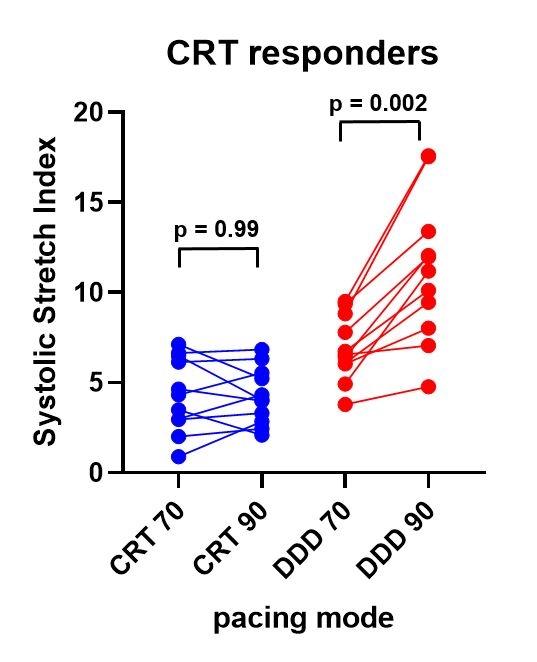EFFECT OF STIMULATION FREQUENCY ON LEFT VENTRICULAR DYSSYNCHRONY IN HEART FAILURE PATIENTS TREATED WITH CARDIAC RESYNCHRONIZATION THERAPY
Background: Limited data exist that higher biventricular (BiV) pacing rate acutely reduces remaining left ventricular (LV) dyssynchrony in cardiac resynchronization therapy (CRT) recipients.
Purpose: The main objective of this study was to quantify the effect of lower and higher paced heart rate on LV dyssynchrony in HF patients treated with BiV stimulation.
Methods: LV mechanical dyssynchrony was assessed by systolic stretch index (SSI) and 12-segment standard deviation model (12-SD) at 4 device setting: atrio-ventricular BiV and right ventricular (RV) pacing, both at 70 and 90 bpm. LV electrical dyssynchrony was evaluated using vectorcardiography.
Results: 28 patients with class I indication for CRT (67±8 years, 16 males, NYHA class 2.0±0.4, LV EF 28±10%) were enrolled. SSI did not change with BiV pacing at 90 bpm compared to 70 bpm (4.7±2.1 vs. 5.4±2.5, p=0.14), whereas significantly increased at 90 bpm compared to 70 bpm with RV stimulation (7.3±2.7 vs. 11.0±4.7, p=0.002). There were no significant changes in 12-SD between 70 and 90 bpm in either pacing mode. In CRT responders, there was no change in SSI with BiV pacing between 70 and 90 bpm, whereas there was a significant increase in SSI with higher BiV stimulation in CRT non-responders (Figure 1). Similarly, there was a trend to decrease in 12-SD in CRT responders with BiV pacing, whereas there was a trend to increase in 12-SD with higher BiV pacing in CRT non-responders. There was no change in QRS area with higher BiV pacing, whereas with higher RV pacing there was a trend to increase.
Conclusions: In CRT responders, BiV stimulation of higher frequency maintains LV mechanical synchrony, whereas higher frequency RV stimulation increases LV mechanical dyssynchrony. Heart rate should be taken into account when evaluating mechanical dyssynchrony using echocardiography in CRT recipients.


